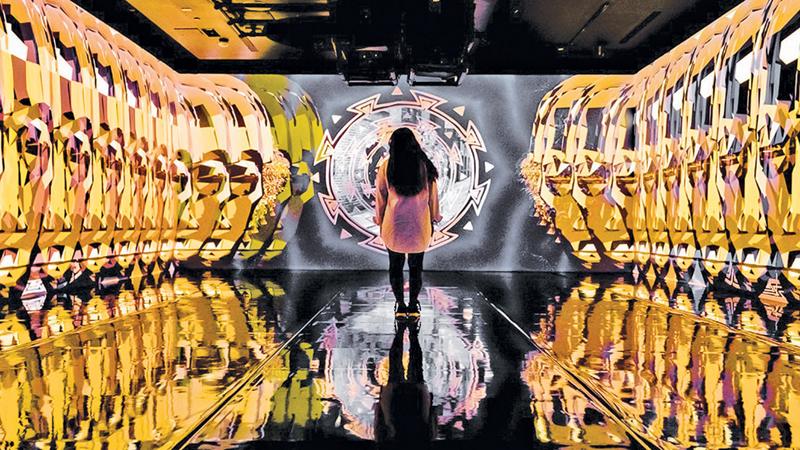
Ase (also spelled ashe) is a Yoruba word that means “the power to make things happen.” A new immersive and interactive digital art exhibit in ARTECHOUSE — the first independent, innovative art organization dedicated to the intersection of art, science and technology — puts that concept on full display. Through its collaboration with London-based Afro-surrealist, visual artist, and illustrator, Vince Fraser, the Miami-based exhibit, Ase: Afro Frequencies explores the idea that Afrocentricity has its own frequencies and metaphorical wavelengths, and celebrates the historical, social, and cultural aspects of Fraser’s identity, as a Black man.
 In celebrating his identity, the exhibit is a celebration of all descendants of the African diaspora — from London to Lagos, from New York to Nairobi, and from Marrakech to Miami.
In celebrating his identity, the exhibit is a celebration of all descendants of the African diaspora — from London to Lagos, from New York to Nairobi, and from Marrakech to Miami.
‘Ase: Afro Frequencies’ fuses modern symbolism and imagery with designs and presentations that bring ancient heritage to life. For example, Fraser’s use of designs that are inspired by African masks specific to different cultures from the continent in conjunction with visuals related to the Black Lives Matter movement. “You don't see many Black artists focusing more on Afro-surrealism. They tend to do more Afro-futurism, which is focusing on the future, as opposed to Afro-surrealism, which is all about the present. It's bringing things from the past and putting them into the present and highlighting them,” Fraser told ’Teen Vogue’.
“My work is classified as Afro-surrealism, so it shows the boundaries and the limitations which we experience as people of color in daily life. I tend to try and portray that or show a lot of those elements in my work, but at the same time, I'm also focusing on paying homage to our ancestors. It's mixing a lot of these different elements together,” he said.
Interactive
His exhibit isn’t just immersive, it’s interactive. In doing so, specifically with his use of imagery that evokes a recollection of where Black people come from, prior to enslavement and the subsequent systems of systemic oppression, Fraser’s exhibit serves as art that is activism in multiple ways. Through its thought-provoking content, and the way it uplifts Black visitors. Which is especially meaningful today, after the global Black Lives Matter movements of 2020, and as the need to continue those conversations in meaningful ways persists.
 “I think in the past there's been too much negativity in terms of art, of how Black people are being portrayed in history. I think now it's really about empowerment and showing positivity, and also inspiring other young creatives coming up to create as well,” says Fraser.
“I think in the past there's been too much negativity in terms of art, of how Black people are being portrayed in history. I think now it's really about empowerment and showing positivity, and also inspiring other young creatives coming up to create as well,” says Fraser.
Another important part of this multi-sensory exhibit is its use of audio. Fraser told Teen Vogue, “I'm very particular about what music I use. For me, music has to provoke a feeling. So when you hear that music, whether it's the African drums, house music, or hip-hop, or whatever — I want people to listen to it, and make them curious about their culture, and provoke that feeling to ask themselves, ‘Where do I come from?’”
The audio also gave Fraser the opportunity to collaborate with another Black artist — American poet, Ursula Rucker, who speaks life into the art and experience. “I wanted her to talk over the drum beat, but it also acts to connect with the actual artwork, so it had to tell a journey and tell a story. We sat down and we spoke about the work and what I was going to present, and then we just merged our ideas together and came up with what we got from it there,” says Fraser.
‘Ase: Afro Frequencies’ came to be through partnerships and collaborations that extend beyond Fraser’s London residence and beyond the African diaspora — in addition to Fraser and Rucker, ARTECHOUSE co-founders Sandro Kereselidze and Tatiana (Tati) Pastukhova were major players in bringing Fraser’s vision to life. The exhibit is a direct reflection of the power of allyship and championing the voices of others. Even more importantly, it’s a combination of art and technology to tell a human story of struggle and triumph.
“For me, it’s about shining the spotlight on Black people. I'm hoping when people go and see the exhibition, it educates them. It's all about inclusivity, equality, empowerment, inspiring people, and motivating people,” said Fraser. “It's a celebration of everything. I hope people, when they go and see it, they'll get all of these different emotions.”
